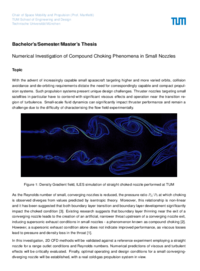Numerical Investigation of Compound Choking Phenomena in Small Nozzles
- Institut
- Lehrstuhl für Raumfahrtantriebe
- Typ
- Bachelorarbeit Semesterarbeit Masterarbeit
- Inhalt
- Beschreibung
Description
With the advent of increasingly capable small spacecraft targeting higher and more varied orbits, collision avoidance and de-orbiting requirements dictate the need for correspondingly capable and compact propulsion systems. Such propulsion systems present unique design challenges. Thruster nozzles targeting small satellites in particular have to contend with significant viscous effects and operation near the transition region of turbulence. Small-scale fluid dynamics can significantly impact thruster performance and remain a challenge due to the difficulty of characterising the flow field experimentally.
As the Reynolds number of small, converging nozzles is reduced, the pressure ratio Pb/P0 at which choking is observed diverges from values predicted by isentropic theory. Moreover, this relationship is non-linear and it has been suggested that both boundary layer transition and boundary layer development significantly impact the choked condition (Nakao et al., 2000). Existing research suggests that boundary layer thinning near the exit of a converging nozzle leads to the creation of an artificial, narrower throat upstream of a converging nozzle exit, inducing supersonic exhaust conditions in small nozzles - a phenomenon known as compound choking (Kubo et al., 2012). However, a supersonic exhaust condition alone does not indicate improved performance, as viscous losses lead to pressure and density loss in the throat (Afroosheh et al., 2017).
In this investigation, 2D CFD methods will be validated against a reference experiment employing a straight nozzle for a range outlet conditions and Reynolds numbers. Numerical predictions of viscous and turbulent effects will be critically evaluated. Finally, optimal operating and design conditions for a small converging-diverging nozzle will be established, with a real cold-gas propulsion system in view.
Tasks
- Familiarisation with literature on boundary layer and compressible flow
- Investigation of compound choking in a straight nozzle using 2D CFD
- Evaluation of existing turbulence modelling methods for predicting compound choking
- Performance prediction of a small converging-diverging nozzle operating across a range of conditions, accounting for viscous and transition effects
- Documentation and presentation of results.
- Voraussetzungen
- Student in Aerospace or Mechanical Engineering.
- Experience with OpenFOAM or Ansys FLUENT desirable
- Interest in Fluid Dynamics
- Möglicher Beginn
- sofort
- Kontakt
-
Tomas Mrazek, M.Eng.
Tel.: +33695349960
tomas.mrazektum.de - Ausschreibung
-
